Europe, British Isles, England, Welsh March, Herefordshire
Herefordshire is in Welsh March.
On 14 Apr 1406 Isabel Grandison (age 66) died at Herefordshire.
Europe, British Isles, England, Welsh March, Herefordshire, Aconbury
On 16 Oct 1714 James Brydges 8th Baron Chandos (age 72) died at Aconbury, Herefordshire. His son James Brydges 1st Duke Chandos (age 41) succeeded 9th Baron Chandos of Sudeley, 4th Baronet Brydges of Wilton in Herefordshire. Cassandra Willoughby Duchess Chandos (age 44) by marriage Baroness Chandos of Sudeley.
Europe, British Isles, England, Welsh March, Herefordshire, Archenfield
On 23 May 1359 Robert Poyntz was born at Archenfield, Herefordshire.
Europe, British Isles, England, Welsh March, Herefordshire, Arkestone
Around 1529 Anne Morgan Baroness Hunsdon was born to Thomas Morgan (age 34) in Arkestone, Herefordshire.
Europe, British Isles, England, Welsh March, Herefordshire, Ashford
Around 1304 Catherine Grandison Countess of Salisbury was born to William Grandison 1st Baron Grandison (age 42) and Sibylla Tregoz Baroness Grandison at Ashford, Herefordshire.
Europe, British Isles, England, Welsh March, Herefordshire, Bishops Frome
Around 1420 William Stafford was born to Humphrey Stafford (age 41) at Bishops Frome, Herefordshire.
Europe, British Isles, England, Welsh March, Herefordshire, Bodenham
In 1361 Walter Devereux was born to Walter Devereux (age 22) at Bodenham, Herefordshire.
Europe, British Isles, England, Welsh March, Herefordshire, Bosbury
Europe, British Isles, England, Welsh March, Herefordshire, Bosbury, Church of the Holy Trinity [Map]
Church of the Holy Trinity, Bosbury [Map].
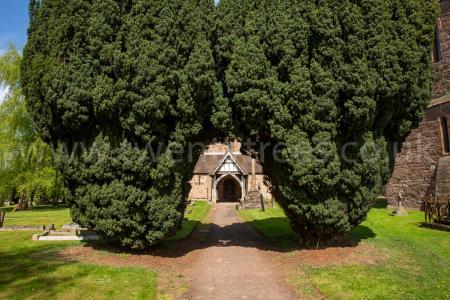
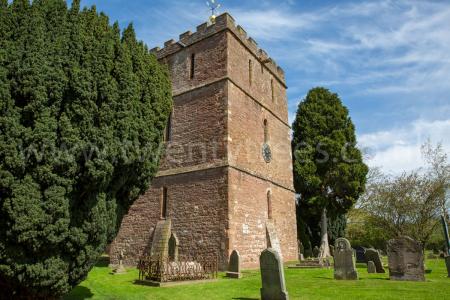
Around 1573. Church of the Holy Trinity, Bosbury [Map]. Monument to John Harford died 1559. Large recessed wall Elizabethan Period monument commemorating John Harford died 1559, signed by John Guldo of Hereford: 'JOHN GULDO of Hereford made this tombe w. his owne hande Ano. Dn. 1573. Pedimented surround with Corinthian columns on tall bases, semi-circular head to arched recess with Ionic capitals to pilasters, recumbent effigy in civil costume on sarcophagus supported by two lions, the whole enriched with rosettes in spandrels and large leaves and rounded in tympanum, shell motif and three panels with vases and two shields and an achievement of arms at back of recess.
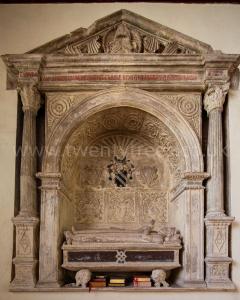
Around 1578. Church of the Holy Trinity, Bosbury [Map]. Monument to Richard Harford died 1578.
Large recessed wall Elizabethan Period monument commemorating Richard Harford died 1578, his wife Martha and Anthony Harford, attributed improbably to John Guldo of Hereford, caryatid-type figures possibly Adam and Eve flank central semi-circular headed arched recess with segmental pediment. Two recumbent effigies, male and female in civil costume on sarcophagus supported by two grotesque animals, the whole enriched with foliage and flock motifs and rather more primitive in style than John Harford memorial on opposite wall.
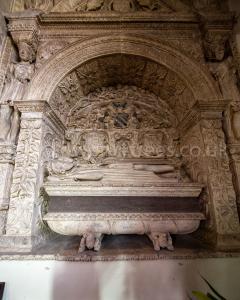
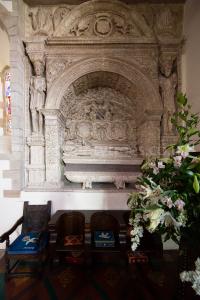
Europe, British Isles, England, Welsh March, Herefordshire, Brampton Bryan
Brampton Bryan Castle
On 21 Oct 1624 Edward Harley was born to Robert Harley (age 45) and Brilliana Conway (age 26) in Brampton Bryan Castle [Map].
On 29 Oct 1643 Brilliana Conway (age 45) died after having defended her home Brampton Bryan Castle [Map] from a three month siege by Royalist troops.
On 07 Jun 1664 Edward Harley was born to Edward Harley (age 39) in Brampton Bryan Castle [Map].
Europe, British Isles, England, Welsh March, Herefordshire, Brampton Bryan Hall
On 11 Oct 1790 Edward Harley 4th Earl of Oxford and Earl Mortomer (age 64) died at Brampton Bryan Hall without issue. His nephew Edward Harley 5th Earl of Oxford and Earl Mortimer (age 17) succeeded 5th Earl of Oxford and Earl Mortimer.
Europe, British Isles, England, Welsh March, Herefordshire, Bredwardine [Map]
In 1413 Elizabeth Vaughan was born to Roger Vaughan of Bredwardine (age 36) and Gwladys ferch Dafydd Gam "Star of Abergavenny" Brecon in Bredwardine, Herefordshire [Map].
Europe, British Isles, England, Welsh March, Herefordshire, Bredwardine Bridge
Constructed from 1762 to 1764. Bredwardine Bridge, Herefordshire over the River Wye. Restored 1921. Brick with some stone dressings. Six arches.
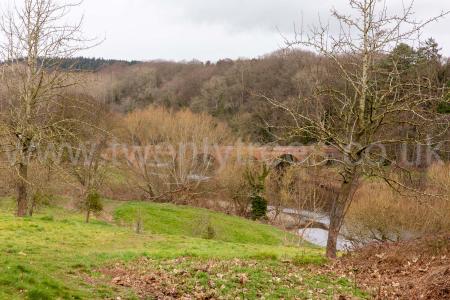
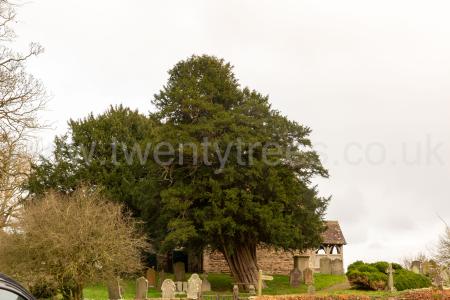
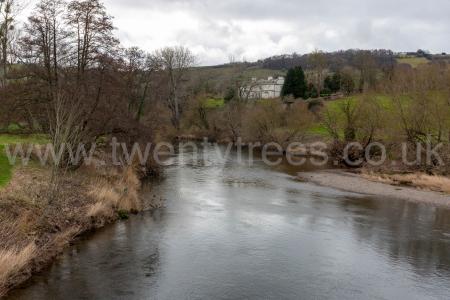
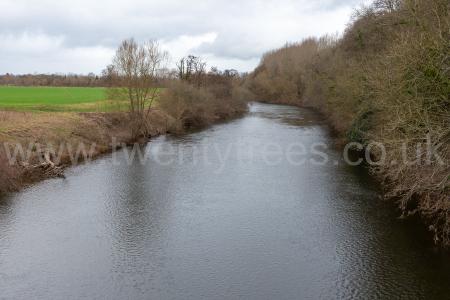
The River Wye rises on Plynlimon [Map] after which it travels through, under, or near, Rhayader [Map], Newbridge-on-Wye [Map], Builth Wells [Map], Llanstephan Suspension Bridge [Map], Glasbury-on-Wye [Map], Hay-on-Wye [Map], Clifford Castle, Herefordshire [Map], Bredwardine, Byford, Herefordshire [Map], Wye Bridge Hereford [Map], Holme Lacy, Herefordshire [Map], Capler Camp, Herefordshire [Map], through Ross-on-Wye, Herefordshire [Map], past Goodrich Castle, Gloucestershire [Map], Monmouth, Monmouthshire [Map], Tintern Abbey [Map] and Chepstow Castle [Map] joining the Severn Estuary 800m south-east of Thornwell, Monmouthshire [Map].
Europe, British Isles, England, Welsh March, Herefordshire, Brompton Brian
On 16 Sep 1294 Elizabeth Brampton was born to Brian Brampton at Brompton Brian, Herefordshire.
Europe, British Isles, England, Welsh March, Herefordshire, Bromyard
In 1174 Richard Talbot (age 52) died at Bromyard, Herefordshire.
On 27 May 1442 Humphrey Stafford (age 63) died at Bromyard, Herefordshire.
Europe, British Isles, England, Welsh March, Herefordshire, Linton Manor Bromyard
In 1122 Richard Talbot was born to Hugh Talbot (age 47) at Linton Manor Bromyard, Herefordshire.
Around 1150 Gilbert Talbot was born to Richard Talbot (age 28) at Linton Manor Bromyard, Herefordshire.
In 1180 Richard Talbot 3rd Baron Talbot was born to Gilbert Talbot (age 30) and Ann Gilbert Villiers (age 28) at Linton Manor Bromyard, Herefordshire.

On 11 Apr 1281 Aline Aliva Basset (age 92) died at Linton Manor Bromyard, Herefordshire.
Europe, British Isles, England, Welsh March, Herefordshire, Byford [Map]
The River Wye rises on Plynlimon [Map] after which it travels through, under, or near, Rhayader [Map], Newbridge-on-Wye [Map], Builth Wells [Map], Llanstephan Suspension Bridge [Map], Glasbury-on-Wye [Map], Hay-on-Wye [Map], Clifford Castle, Herefordshire [Map], Bredwardine, Byford, Herefordshire [Map], Wye Bridge Hereford [Map], Holme Lacy, Herefordshire [Map], Capler Camp, Herefordshire [Map], through Ross-on-Wye, Herefordshire [Map], past Goodrich Castle, Gloucestershire [Map], Monmouth, Monmouthshire [Map], Tintern Abbey [Map] and Chepstow Castle [Map] joining the Severn Estuary 800m south-east of Thornwell, Monmouthshire [Map].
Europe, British Isles, England, Welsh March, Herefordshire, Byford, St John the Baptist Church [Map]
St John the Baptist Church, Byford [Map]. Lots of monuments to the Cotterell Baronents, a marble wall monument by J Smth of London, Lettice Lygon eldest daughter of William Lygon 7th Earl Beauchamp.
Europe, British Isles, England, Welsh March, Herefordshire, Capler Camp [Map]
The River Wye rises on Plynlimon [Map] after which it travels through, under, or near, Rhayader [Map], Newbridge-on-Wye [Map], Builth Wells [Map], Llanstephan Suspension Bridge [Map], Glasbury-on-Wye [Map], Hay-on-Wye [Map], Clifford Castle, Herefordshire [Map], Bredwardine, Byford, Herefordshire [Map], Wye Bridge Hereford [Map], Holme Lacy, Herefordshire [Map], Capler Camp, Herefordshire [Map], through Ross-on-Wye, Herefordshire [Map], past Goodrich Castle, Gloucestershire [Map], Monmouth, Monmouthshire [Map], Tintern Abbey [Map] and Chepstow Castle [Map] joining the Severn Estuary 800m south-east of Thornwell, Monmouthshire [Map].
Europe, British Isles, England, Welsh March, Herefordshire, Clehonger
In 1420 Thomas Barre (age 71) died at Clehonger, Herefordshire.
Europe, British Isles, England, Welsh March, Herefordshire, Clehonger, All Saints' Church [Map]
All Saints' Church, Clehonger [Map]. Effigy of Richard Pembridge of Clehonger, Clehonger, Herefordshire.
Monumental Effigies. A Knight of the Pembridge Family in Clehongre Church, Herefordshire [Map]. [Note. Possibly Richard Pembridge of Clehonger?]
Richard Pembridge of Clehonger: he and Petronilla Unknown were married. All Saints' Church, Clehonger. Effigy of Richard Pembridge of Clehonger, Clehonger, Herefordshire. Around 1300 he was born in Pembridge, Herefordshire. In 1346 he died.
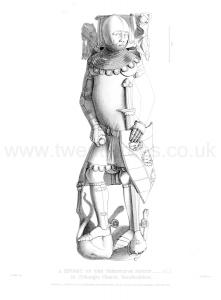
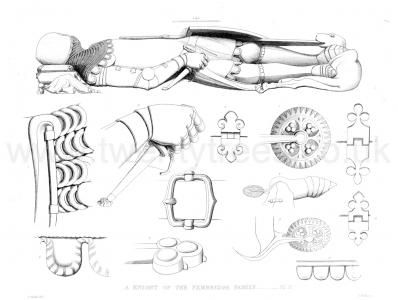
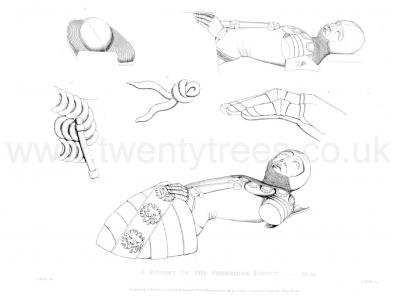
Europe, British Isles, England, Welsh March, Herefordshire, Colwall
Europe, British Isles, England, Welsh March, Herefordshire, Colwall, St James the Great Church
St James the Great Church, Colwall. Herefordshire School of Carving. The Norman church was started in the 12th century as evidenced by the main south doorway with its scalloped capitals and a round headed arch on the west front of the nave. The south aisle was added in the middle of the 13th century. The south west tower is unusually situated and houses ten bells with six dating from 1778. In 1865 the chancel was replaced and widened and in 1880 the north aisle was added. In 2010 the chancel was reordered.
Europe, British Isles, England, Welsh March, Herefordshire, Croft
Europe, British Isles, England, Welsh March, Herefordshire, Dewsall
On 06 Jan 1673 James Brydges 1st Duke Chandos was born to James Brydges 8th Baron Chandos (age 30) and Elizabeth Barnard Baroness Chandos (age 30) at Dewsall, Herefordshire.
Europe, British Isles, England, Welsh March, Herefordshire, Dore Abbey [Map]
On 03 Apr 1286 Roger Clifford (age 71) died of wounds sustained in battle. He was buried at Dore Abbey, Herefordshire [Map].
Europe, British Isles, England, Welsh March, Herefordshire, Dorstone
Europe, British Isles, England, Welsh March, Herefordshire, Dorstone, Arthur's Stone Long Barrow [Map]
Arthur's Stone Long Barrow is also in Cotswolds Neolithic Tombs.
Transactions of the Woolhope Club 1881 Golden Valley Meeting. To this modern description we are fortunately enabled to add some most interesting particulars, written by an intelligent and competent observer, who made a personal inspection of this interesting object, at the beginning of the reign of Queen Anne, or about 180 years ago.
In the first English Edition of Camden's Britannia, which was published in the year 1610, no mention is made of Arthur's Stone, nor is it marked on Speed's Map of that date. The other writer referred to is Nathaniel Salmon, a Bachelor of Laws, Antiquary and Historian, who was born circa 1676, son of the Rev. Thomas Salmon, also an antiquary. In Salmon's book, published in 1728 and 1729, entitled "A new Survey of England, wherein the defects of Camden are supplied and the errors of his followers remarked," he says, — "The remarkable curiosity of Rolle-Rich Stones [Map] (in Oxfordshire) hath not been sufficiently explained, either as to the original Form of that Monument, the age of it, or the Intention of the Erection. Out of the several Guesses that have been made, some hints may be taken, and seem capable of Improvement.
"Comparing that of Stonehenge with tliis, and the other in Cornwall, mentioned by the Right Reverend Annotator upon Camden, and a fourth which I have seen about twenty-five years ago, in Herefordshire, I am of opinion they are all the work of the same age, and made with the same intention."
"If my conjecture be right that of Herefordshire having more Remains of its Ancient Figure than any of the rest, is first to be described."
" Upon a hill west of the river Wye above Bradwardyn Castle, in the way toward the Black Mountains, is a flat, oblong stone, or a number of stones joined together, lying upon the pedestals of rude upright stones fix'd in the earth, after the manner of Rolle-Rich. A great part of the work is entire ; the supporting stones being at the same distance from the verge of that they bear. The eastern point (as I remember it was eastern), is narrower than the rest as much as the eastern part of a gravestone. It seems to have increased in breadth toward the west, but the western end being demolished, as well the upper stones as the pedestals, neither the length of the whole nor the breadth of the western part can be determined. What remains (as I remember), was about six yards long, and two yards broad. The flat stone was then in three pieces, but the sides of those pieces answering one another, and not joining as they would have been made to do if they had been originally single, but indented like something broken, I take them to have been but one at first. From whatever quarry it was brought, or by whatever carriage, it hath the air of a natural stone, not of one put together with a strong cement. Its height from the ground was about twenty inches. I remember the sheep of the country, which are small, sheltered themselves under it from the sun. The name by which the country people call this, is Artil's Stone [Map], corrupted probably from Arthur's Stone. This may have been taught them by somebody that had a notion of Arthur's Round Table, thinking this erected with the same design. Or supposing this to be of the same age and design with Stonehenge, the memory of Arthur may be kept up by its similitude to the other, for Arthur, according to our Monkish History was a great man ; and the honour attributed to Aurelius Ambrosius, who took upon him the government of the Britons when their affairs were desperate, after the departure of the Romans, Arthur is always allowed to share in. This might be from Arthur's being a Briton, whereas the other was half if not wholly of Roman blood."
Collections Towards the History and Antiquities of the County of Herefordshire by John Duncumb, A.M. Terra antiqua, potens armis atque ubere glebe. Virgil Æneid. [Ancient, mighty in arms and fertile soil].
Title Page Drawing of Arthur's Stone Long Barrow [Map]
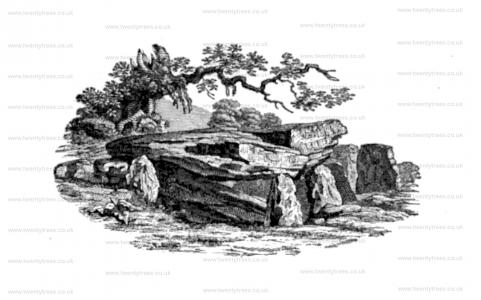
Transactions of the Woolhope Club 1872 Meeting at Bredwardine. Meeting at Bredwardine. Friday, July 26th, 1872.
The party re-assembled at the cromlech, or so-called druidical monument known as King Arthur's Stone [Map], which is situated in the middle of an ancient road, probably British, leading along the ridge to Herbage Point, and thence to Clock-mill where it joins the road to Hay along the south bank of the Wye. Arthur's Stone has been so often described as to need little to be said about it, save that it is a true cromlech evidently of great antiquity. It consists of a superincumbent slab of old red sandstone, probably brought from a neighbouring quarry on the west or Dorstone slope of the ridge, which is now broken in two ways. The lower stratum has become detached from the upper, and has fallen partly to the ground, while the upper portion, which is about two feet thick, and is estimated to be about 40 tons in weight, is split across the middle. The stone, however, is still supported by the six smaller stones upon which it was originally placed. It is surrounded at about eight feet distance by a circle of stones of considerable size, which are now mostly covered with greensward. There seems to have been an inner circle of upright stones about four feet high, of which only four are now to be traced, the remainder having probably been broken up and carried off to mend the road, or for some other purpose. One of these stones, which is singularly marked as though with a gigantic thumb and two fingers, lies on the roadside, where it is shown by some relaters of local tradition as bearing the marks of King Arthur's knees, as he knelt down, while others declare that the marks are those of his thumb and fingers, when he was playing at quoits. The marks themselves seem to have been produced by water, and are analogous to those produced upon the edge of a bed of rock where the stream breaks into tiny cascades, such as are common in the bed of the Wye near Builth and elsewhere. How the stone reached its present position is of course a matter for conjecture, but it is probable that it was with the other smaller stones brought from the Wye.
On the Dorstone slope of the hill, and in the valley, some large travelled stones are found, which would seem to suggest that at one time there had been an avenue of stones marking the ascent to the cromlech.
It is much to be regretted that this interesting relic of a far-off time is left in its present state of utter neglect, a prey not only to the destructive action of the seasons, but also to the heedless ravages of mankind. It would require no great expenditure at least to clear the outer circle of stones of the earth which has accumulated upon them, and thus to lay bare to the observer the exact nature of the place, and it would be a trivial sacrifice of land to divert the road a little to the eastsward, so as to save that side of the circle from further destruction. It is possible that the excavation necessary for the purpose would be rewarded by discoveries of articles of interest, but in any case the diversion of the road would be an easy way of presenting this fine relic from casual or wanton damage. As the only monument of its class in the county, it merits some little care for its own sake, while such care would relieve the archaeologists of the county of some discredit which the present neglected condition of the stone justly throws upon them.
As the party were grouped around the stone, the Vice-Presidents and some other gentlemen present invited Mr. Edmunds to say a few words on its history.
Mr. Edmunds, in responding to the unexpected call, said that he was much in the position of Canning's knife-grinder, when asked for his story:
Story, Lor' bless ye, I have none to tell. Sir!
He had not been able to find any historical references to King Arthur's Stone, while the legends were few and imperfect, yielding no distinct ground even for plausible conjecture as to the person to whom or the time when that structure was reared. The name was rather patriotism than history. There is no reason for supposing that King Arthur ever ruled in this district. It is true that the existence of Arthur had been disputed, but the doubt seemed to the speaker an unreasonable one. There was certainly a real King Arthur who ruled the district now known as Somerset, Devon, and Cornwall, and whose body was found buried at Avallonia in the reign of Henry II., but there is no reason for connecting him with this cromlech unless we take the name as a patriotic myth. As the great national hero, Arthur was to the Briton the symbol of the glorious past of their independence, and everything remarkable or interesting seemed to be consecrated by bearing the name of Arthur. Thus we have mountains, cromlechs, stones, and other objects in distant places where Arthur never ruled, as well as in his own little kingdom, named from the hero-king. Of course where nothing certain was known there was a fine field for conjecture (a laugh). The archaeologists had "ample room and verge enough" for theory. There were indeed some facts, very massive and imposing and undeniable ; there was the huge table of stone, the crom-lech, or covering stone, its firmly fixed supports, the remains of a small inner circle, and the large outer circle covered with earth and greensward, and fragrant with purple thyme and other wild flowers, upon which the audience were seated. These were the facts, and all he could do was but to endeavour to explain them from other monuments of the kind which he had visited. The ground plan, for example, seemed to be a miniature of that of Stonehenge, which, however, had no central cromlech. He thought it was probable that the circle had been double, a passage being thus left all round, although only one of the inner ring of stones was left standing. The circular form was to his mind conclusive evidence of British work. The Briton's mind seems to have been full of the circle: the circle of the heavens, the circle of the sun, the circle of the moon, the circle of the seasons, seem to have suggested the idea, which the Briton carried out in his camps, his dwellings, his temples, his burial places. Just as the Roman founded all his works on the right line and always used the square or the oblong, a square and a half. In this case, he thought the cromlech was built first. Some great Silurian chief was brought thither with rude pomp and ceremony ; his body was placed on the ground, covered perhaps with a little earth ; the body of his favourite horse was laid at his feet, and his weapons by his side, and the huge Lech or covering stone was brought up an inclined plane upon rollers, and so placed by the strong arms of a nation as a memorial of their lost chief to future ages. All this would be done, as the old British phrase has it, "in the face of the sun and in the eye of light," and amid a band of white-robed Druids and bards, while the armed throng formed a reverent circle around. Then, too, at night, if we might follow some interpreters of the bards, the hollow place beneath the cromlech might be used in the initiation of neophytes. Lonely watching in the house of death has always been supposed to confer wisdom, and especially prescience, upon the watcher, who regarded it as the house of life to his spirit. Here he communed with the invisible world, and from hence he issued after his vigils (like the knight of mediaeval times) pledged to a new life. Perhaps he ought to apologise for detaining the audience so long with these theories and conjectures, but he had told them that he had little of information to give them ; and they would all agree with him that when one has really little to say it sometimes takes a great many words to say it (applause).
The Rev. James Davies expressed the obligations of the meeting to Mr. Edmunds for his most interesting address, and added that if that was an instance of a person having little to say they all felt that Mr. Edmunds had said it extremely well (applause).
Mr. Lloyd also expressed the interest which he had felt in the address.
Mr. J. E. Smith said that some writers looked upon Arthur as the sun, and the legends regarding him as myths of the sun-worship. "Ar" was said to be a word meaning light.
Mr. Edmunds doubted the correctness of that theory. He knew the word ar as meaning land, and lux and cognate words as meaning light, in the Celtic and Teutonic tongues, but he knew nothing of ar as meaning light in those tongues.
Sir George Cornewall, who had arrived while Mr. Edmunds was speaking, expressed his regret that he had accidentally missed the address. What he had heard had greatly interested him.
The party then made their way to the beautiful "Clumps" above the village of Bredwardine, where they partook of lunch. Afterwards the club held an ordinary meeting, when some formal business was transacted.
Sir George Cornewall then announced that the only paper to be read that day was that of Mr. Edmunds and Mr. Curley, who had visited the scene of the destructive whirlwind of Sunday week. (See the succeeding page.)
Transactions of the Woolhope Club 1881 Golden Valley Meeting. Golden Valley Meeting. May 25th, 1882. Arthur's Stone, Dorstone, By Mr. George H. Piper, F.G.S., President.
The very fine, and tolerably well-preserved Cromlech (Welsh, from crom, bent, arched or covering ; llec a flat stone) on Merbage Hill, in the parish of Dorstone, known by the name of "Arthur's Stone [Map]," is one of the most perfect Druidic structures in our Island.
Cromlechs in British antiquities, are huge, broad, flat stones, raised upon other stones set up on end for that purpose.

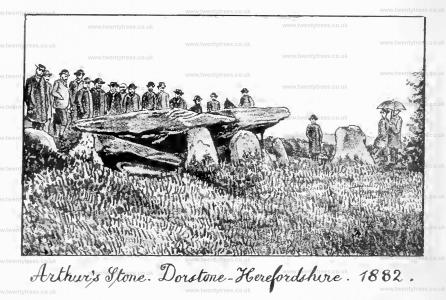
Transactions of the Woolhope Club 1900 Arthur's Stone. Arthur's Stone [Map], Dorstone. By H. Cecil Moore.
For previous remarks on Arthur's Stone, see the paper by Mr. Piper in Transactions 1882, page 175. Subsequently to the visit of our Club to Arthur's Stone, and whilst the Volume of our Transactions is in the press, circumstances have called more than usual attention to one of our most ancient megalithic monuments, viz., Stonehenge (Saxon Stán-henge, the hanging stones). The dislodgment, in the latter part of December, 1900, of one of the capstones of a trilithon in the outer circle, has led to certain protective work being carried out and to the placing of the well-known "leaning stone" of one of the tallest separate trilithons in an upright and thoroughly secure position. This newly-erected colossus is about 21 feet in height, and the portion of stone underground measured 8 feet. In the work of excavation stone hammers, heavy mauls for rough dressing the stones, and chips were uncovered, and not a single metal tool of any kind was discovered, indicating so far that the stones were erected previous to the bronze age. From thousands of other finds in England the bronze age is placed between 1800 and 2000 B.C. Moreover the character of the mauls, heavy hand instruments, unpolished and not fixed in handles after the manner of neolithic instruments, is suggestive of Old Stone Age rather than Neolithic implements.
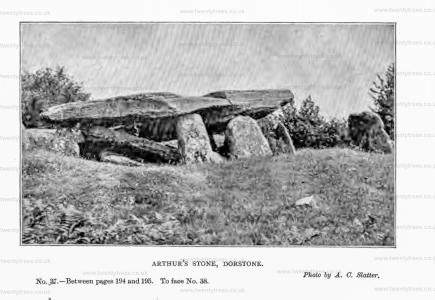
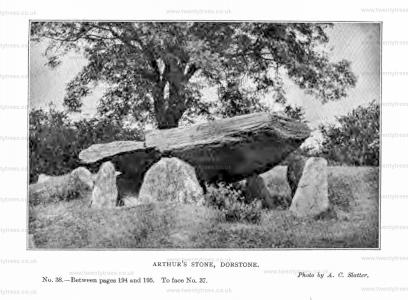
Long Barrows of the Cotswolds. Arthur's Stone Long Barrow [Map]
Europe, British Isles, England, Welsh March, Herefordshire, Eardisley
Eardisley Castle
Around 1080. Eardisley Castle [Map] is an 11th-century motte and bailey castle with a moat around the bailey. It is recorded in the Domesday Book as being held by Robert (probably Robert de Basqueville, father of Ralph de Baskerville) from Roger de Lacy.
In 1263 John Giffard 1st Baron Giffard Brimpsfield (age 31) was imprisoned Bishop Peter Acquablanca at Eardisley Castle [Map].
Europe, British Isles, England, Welsh March, Herefordshire, Eardisley, Lower Moor
On 06 Oct 1833 Susanna Matilda Tayler (age 42) died at Lower Moor, Eardisley.
Europe, British Isles, England, Welsh March, Herefordshire, Eastnor
Europe, British Isles, England, Welsh March, Herefordshire, Eastnor, St John the Baptist Church [Map]
St John the Baptist Church, Eastnor [Map]. Monument to Charles Somers-Cocks 3rd Earl Somers by Joseph Edgar Boehm. Two angels support his pillow. The monument is located in the mortuary chapel to the north of the church.
On 26 Sep 1883 Charles Somers-Cocks 3rd Earl Somers (age 64) died. Earl Somers, Viscount Eastnor of Eastor Castle in Herefordshire extinct. He was buried at St John the Baptist Church, Eastnor [Map]. His first cousin once removed Philip Reginald Cocks 5th Baron Somers (age 68) succeeded 5th Baron Somers.
Europe, British Isles, England, Welsh March, Herefordshire, Ecclesall
In 1250 Richard Talbot 4th Baron Talbot was born to Gilbert Talbot (age 30) and Gwenllian Dinefwr (age 31) at Ecclesall, Herefordshire.
In 1274 Catherine Talbot was born to Richard Talbot 4th Baron Talbot (age 24) and Sarah Beauchamp Baroness Talbot (age 19) at Ecclesall, Herefordshire.

Around 1277 Joan Talbot was born to Richard Talbot 4th Baron Talbot (age 27) and Sarah Beauchamp Baroness Talbot (age 22) at Ecclesall, Herefordshire.

In 1278 Richard Talbot 5th Baron Talbot was born to Richard Talbot 4th Baron Talbot (age 28) and Sarah Beauchamp Baroness Talbot (age 23) at Ecclesall, Herefordshire.

In 1287 Thomas Talbot was born to Richard Talbot 4th Baron Talbot (age 37) and Sarah Beauchamp Baroness Talbot (age 32) at Ecclesall, Herefordshire.

On 03 Sep 1306 Richard Talbot 4th Baron Talbot (age 56) died at Ecclesall, Herefordshire.
Europe, British Isles, England, Welsh March, Herefordshire, Elton
Europe, British Isles, England, Welsh March, Herefordshire, Ewyas Harold
In 1178 Sybil Ewyas was born to Robert Ewyas at Ewyas Harold, Herefordshire.
In 1232 Roger Clifford (age 43) died at Ewyas Harold, Herefordshire.
In 1236 Sybil Ewyas (age 58) died at Ewyas Harold, Herefordshire.
Around 06 Aug 1285 Juliana Cantilupe (age 61) died at Ewyas Harold, Herefordshire.
On 24 May 1297 Mabel Fitzwarin (age 50) died at Ewyas Harold, Herefordshire.
Europe, British Isles, England, Welsh March, Herefordshire, Ewyas Lacy [Map]
On 01 Nov 1206 Gilbert Lacy was born to Walter Lacy Lord Meath (age 40) and Margaret de Braose at Ewyas Lacy, Herefordshire [Map].

Around 1228 Margaret "Lady of Dulek" Lacy was born to Gilbert Lacy (age 21) and Isabel Bigod (age 16) at Ewyas Lacy, Herefordshire [Map].

Around 1379 Margaret Burghesh was born to John Burghesh (age 35) and Ismania Hanham at Ewyas Lacy, Herefordshire [Map].
Calendars. 16 May 1483. King Richard III of England (age 30). Westminster Palace [Map]. Grant for life to the king's servant Henry Duke of Buckingham (age 28), of the offices of chief justice and chamberlain in South and North Wales, constable of the castles and counties of Kermerdyn and Cardigan, the castles of Abrustwith, co Cardigan, and Denevour in South Wales, the castle and town of Tonebigh, co. Pembroke, the castle and lordship of Kylgarvan in South Wales, the castle and town of Llan Stepham in South Wales, the lordship of Wallewynscastell in South Wales, the lordship of Westhaverford in South Wales, constable, steward, and receiver of the castle, lordshiop and manor of Uske, the castle and lordship of Carlion, the castle, lordship and manor of Dynas, the castle and a moiety of the lordship of Ewyas Lacy [Map], the castles, lordships and manors of Belth,Clifford, Radnore, Melenyth, Montgomery, Dynbigh, Elvell and Narberth, the castle, lordship and manors of Wygmore [Map] and Holt [Map] in the marches of Wales, and the lordship and manor of Bromfield [Map] in the same marches, steward and receiver of the lordships and manors of Norton, Knyghton, Raydor, Guerthrenyon, Comotoyder, Glasbury, Weryfreton, Cherbury, Terthic, Halcetur, Kadewyn, Newton, Kyry in the marches.

Europe, British Isles, England, Welsh March, Herefordshire, Harewood
Europe, British Isles, England, Welsh March, Herefordshire, Harewood, St Denis' Church
On 12 Sep 1705 John Hoskyns 2nd Baronet (age 71) died. He was buried in St Denis' Church, Harewood. His son Bennet Hoskyns 3rd Baronet (age 30) succeeded 3rd Baronet Hoskyns of Harewood in Herefordshire
In 1724 Jane Lowe Lady Hoskyns died. She was buried in St Denis' Church, Harewood.
Europe, British Isles, England, Welsh March, Herefordshire, Hay on Wye [Map]
Europe, British Isles, England, Welsh March, Herefordshire, Kilpeck
Alan de Plunkett of Kilpec was born to Alan de Plugenet of Kilpec. His sister Joan Plugenet of Kilpec was his heir and inherited Kilpeck, Herefordshire.
Europe, British Isles, England, Welsh March, Herefordshire, King's Caple
On 12 Apr 1879 Anne Coke (age 82) died at King's Caple, Herefordshire. She was buried at the Church of St Mary Magdalene, Eardisley [Map].
Europe, British Isles, England, Welsh March, Herefordshire, Kington
Europe, British Isles, England, Welsh March, Herefordshire, Kington, St Mary's Church [Map]
After 24 Jul 1469. St Mary's Church, Kington [Map]. Genealogy of Thomas Vaughan and Ellen Gethen.
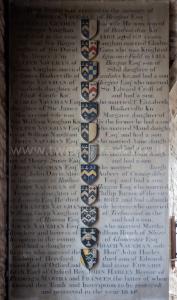
After 26 Jul 1469. St Mary's Church, Kington [Map]. Thomas Vaughan killed 26 Jul 1469 at the Battle of Edgecote Moor and wife Elena "Terrible" Gethen so called because she murdered her cousin who had murdered her brother. Alabaster. Early Plate Bascinet Period. Tassets. Believed to have been moved from the Chancel since it is decorated on all sides. Possible Harpur and Moorecock of Burton on Trent - see the folds at the base of her dress and the possible little dog between them. Chest with Angels with Rounded Wings holding Shields.
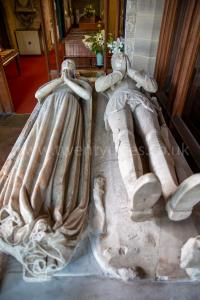
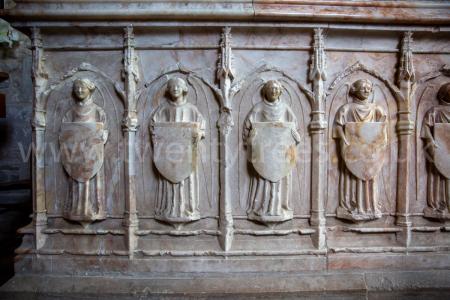
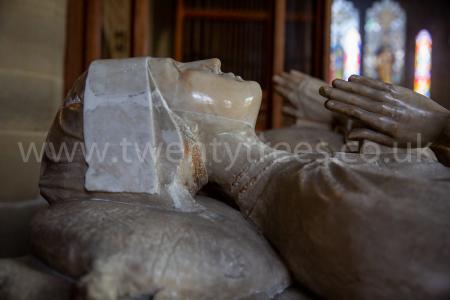
After 1918. St Mary's Church, Kington [Map]. WWI Memorial.
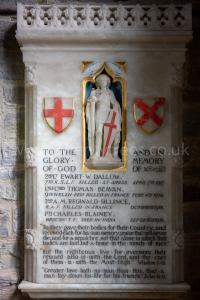
Europe, British Isles, England, Welsh March, Herefordshire, Ledbury [Map]
Florence of Worcester Continuation. 15 Aug 1127. Richard, bishop of Hereford, died at his vill, called Dydelebyrig [Map]1, on Monday the eighteenth of the calends of September [15th August]; his body was carried to Hereford [Map], and buried in the church there, with the bishops his predecessors.
Note 1. Ledbury [Map], Herefordshire.
Europe, British Isles, England, Welsh March, Herefordshire, Ledbury, Ashperton
In 1292 Bishop John Grandison 3rd Baron Grandison was born to William Grandison 1st Baron Grandison (age 30) and Sibylla Tregoz Baroness Grandison at Ashperton, Ledbury.
Around 1294 Mabilia Grandison was born to William Grandison 1st Baron Grandison (age 32) and Sibylla Tregoz Baroness Grandison at Ashperton, Ledbury.
Around 1340 Isabel Grandison was born to Piers Grandison 2nd Baron Grandison and Blanche Mortimer Baroness Grandison (age 28) at Ashperton, Ledbury.
In 1347 John Grandison was born to Piers Grandison 2nd Baron Grandison and Blanche Mortimer Baroness Grandison (age 35) at Ashperton, Ledbury.
In 1350 Mabilia Grandison (age 56) died at Ashperton, Ledbury.
On 10 Aug 1358 Piers Grandison 2nd Baron Grandison died at Ashperton, Ledbury. His brother Bishop John Grandison 3rd Baron Grandison (age 66) succeeded 3rd Baron Grandison.
Piers Grandison 2nd Baron Grandison was born to William Grandison 1st Baron Grandison and Sibylla Tregoz Baroness Grandison at Ashperton, Ledbury.
Europe, British Isles, England, Welsh March, Herefordshire, Ledbury, St Michael and All Angels Church [Map]
St Michael and All Angels Church, Ledbury [Map]. Monument to William Miles (d.1803) by John Flaxman. A small unnamed boy apparently asleep lies under the watchful care of two angels at Ledbury. Sculptors Thomas and Mary Thorneycroft.
Europe, British Isles, England, Welsh March, Herefordshire, Leominster
Anglo-Saxon Chronicle. 1052. At this time Griffin, the Welsh king, plundered in Herefordshire till he came very nigh to Leominster, Herefordshire; and they gathered against him both the landsmen and the Frenchmen from the castle; and there were slain very many good men of the English, and also of the French. This was on the same day thirteen years after that Edwin was slain with his companions.
In 1419 John Croft (age 55) died in Leominster, Herefordshire.
In 1505 Philip Hoby was born to William Hoby of Leominster in Herefordshire and Catherine Forster, probably at Leominster, Herefordshire.
Around 1588 Henry Townshend (age 51) was appointed Recorder of Leominster, Herefordshire.
Europe, British Isles, England, Welsh March, Herefordshire, Leominster, Berrington Hall
In 1778 Thomas Harley (age 47) commissioned the building of Berrington Hall.
In 1781 George Rodney 2nd Baron Rodney (age 27) and Anne Harley Baroness Rodney (age 21) were married. Her father Thomas Harley (age 50) gave them Berrington Hall as a wedding gift.
Europe, British Isles, England, Welsh March, Herefordshire, Leominster Priory [Map]
Leominster Priory, Herefordshire [Map]In the churchyard are graves and memorials of members of the theatrical Kemble family including the grandparents of actress Sarah Siddons. The churchyard also contains one war grave of a soldier of the Royal Army Service Corps of World War II. The church is especially notable for the superb 12th-century carving of the west doorway, which has exceptional carved capitals inside and out. This carving was executed by the 'Herefordshire' school of craftsmen, who were also responsible for the superb churches at Kilpeck and Shobdon, among others in the area. One of the interior capitals depicts a Green Man, the wild man of the woods figure linked to pagan fertility symbols.
Around 660 Merewalh Magonsaete founded at Leominster Priory, Herefordshire [Map].
The Itinerary of Archbishop Baldwin through Wales: Book 2 Chapter 13. From Wenloch, we passed by the little cell of Brumfeld,180 the noble castle of Ludlow [Map], through Leominster [Map] to Hereford [Map] leaving on our right hand the districts of Melenyth and Elvel; thus (describing as it were a circle) we came to the same point from which we had commenced this laborious journey through Wales.
Note 180. It appears that a small college of prebendaries, or secular canons, resided at Bromfield in the reign of king Henry I.; Osbert, the prior, being recorded as a witness to a deed made before the year 1148. In 1155, they became Benedictines, and surrendered church and lands to the abbey of St. Peter's at Gloucester, whereupon a prior and monks were placed there, and continued till the dissolution. An ancient gateway and some remains of the priory still testify the existence of this religious house, the local situation of which, near the confluence of the rivers Oney and Teme, has been accurately described by Leland.
Europe, British Isles, England, Welsh March, Herefordshire, Letton
Europe, British Isles, England, Welsh March, Herefordshire, Mortimer's Cross [Map]
On 02 Feb 1461 at the Battle of Mortimer's Cross at Mortimer's Cross, Herefordshire [Map] the future King Edward IV of England (age 18) commanded the Yorkist forces including William Hastings 1st Baron Hastings (age 30), John Wenlock 1st Baron Wenlock (age 61), John Tuchet 6th Baron Audley, 3rd Baron Tuchet (age 35), John Savage (age 17) and Roger Vaughan (age 51).




In the Lancastrian army Owen Tudor (age 61) (captured by Roger Vaughan (age 51)) and his son Jasper Tudor 1st Duke Bedford (age 29) fought as well as James Butler 1st Earl Wiltshire 5th Earl Ormonde (age 40) and Henry Roos. Gruffydd ap Nicholas Deheubarth (age 68) were killed. Watkin Vaughan (age 66) and Henry Wogan (age 59) were killed.


Monument to the Battle of Mortimer's Cross at Mortimer's Cross, Herefordshire [Map]. Note the mistake - Edward IV described as Edward Mortimer. The monument was erected by subscription in 1799.
Gruffydd ap Nicholas Deheubarth: In 1393 he was born to Nicolas ap Philip Deheubarth and Jonet Unknown at Sheffield.
Watkin Vaughan:
Around 1395 he was born to Roger Vaughan of Bredwardine and Gwladys ferch Dafydd Gam "Star of Abergavenny" Brecon.
Around 1435 Watkin Vaughan and Elinor Wogan were married. The date based on his age being around twenty. The difference in their ages was 29 years.
Henry Wogan: In 1402 he was born to John Wogan at Wiston.
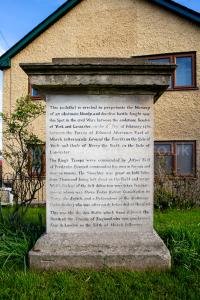
Welsh Border Road describes an unamed Roman Road, and unnumbered by Margery, that went from Caerleon [Map] to Wroxeter, Shropshire [Map], passing through Usk, Monmouthshire [Map], Abergavenny, Monmouthshire [Map], Hereford [Map], Mortimer's Cross, Herefordshire [Map], Wigmore, Herefordshire [Map] and Leintwardine Bridge, Herefordshire [Map] where it crosses the River Teme just after its convergence with the River Clun.
Europe, British Isles, England, Welsh March, Herefordshire, Much Dewchurch
Europe, British Isles, England, Welsh March, Herefordshire, Much Dewchurch, St David's Church
Europe, British Isles, England, Welsh March, Herefordshire, Ocle Pychard
Around 1695 George Carpenter 2nd Baron Carpenter was born to George Carpenter 1st Baron Carpenter (age 37) and Alice Caulfeild Baroness Carpenter (age 34) at Ocle Pychard, Herefordshire.
Europe, British Isles, England, Welsh March, Herefordshire, Pembridge
Around 1300 Richard Pembridge of Clehonger was born in Pembridge, Herefordshire.
Europe, British Isles, England, Welsh March, Herefordshire, Pembridge, St Mary's Church
Calendars. 28 Apr 1485. Presentation of Cardinal Christopher Bainbridge (age 21) to the parish church of Pembrige, in the diocese of Hereford, void by the resignation of [his uncle] Thomas, Bishop of Salisbury.
Europe, British Isles, England, Welsh March, Herefordshire, Peterstowe
On 12 Sep 1637 Giles Brydges 1st Baronet (age 64) died at Peterstowe, Herefordshire. His son John Brydges 2nd Baronet (age 13) succeeded 2nd Baronet Brydges of Wilton in Herefordshire. Mary Powell Lady Wilton by marriage Lady Brydges of Wilton in Herefordshire.
Europe, British Isles, England, Welsh March, Herefordshire, Ross-on-Wye [Map]
The River Wye rises on Plynlimon [Map] after which it travels through, under, or near, Rhayader [Map], Newbridge-on-Wye [Map], Builth Wells [Map], Llanstephan Suspension Bridge [Map], Glasbury-on-Wye [Map], Hay-on-Wye [Map], Clifford Castle, Herefordshire [Map], Bredwardine, Byford, Herefordshire [Map], Wye Bridge Hereford [Map], Holme Lacy, Herefordshire [Map], Capler Camp, Herefordshire [Map], through Ross-on-Wye, Herefordshire [Map], past Goodrich Castle, Gloucestershire [Map], Monmouth, Monmouthshire [Map], Tintern Abbey [Map] and Chepstow Castle [Map] joining the Severn Estuary 800m south-east of Thornwell, Monmouthshire [Map].
Europe, British Isles, England, Welsh March, Herefordshire, Rotherwas
Around 1349 Thomas Barre was born to Thomas Barre (age 14) and Hawise Pembridge (age 11) at Rotherwas, Herefordshire.
Europe, British Isles, England, Welsh March, Herefordshire, Rowlestone
Europe, British Isles, England, Welsh March, Herefordshire, Shobdon
Domesday Book Herefordshire Hezetre. Shobdon. Land of Ralph of Mortimer Households Households: 20 villagers. 20 smallholders. 6 slaves. 2 other. Land and resources Ploughland: 3 lord's plough teams. 9 men's plough teams. Other resources: Woodland 1 * 1 leagues. Valuation Annual value to lord: 7 pounds in 1086; 6 pounds in 1066. Owners Tenant-in-chief in 1086: Ralph of Mortimer. Lord in 1086: Ralph of Mortimer. Lord in 1066: (Queen) Edith. Phillimore reference: Herefordshire 9,10
Before 1148 Abbot Simon Merlymond was the first Abbot of Wigmore Abbey [Map]. The community moved around Herefordshire, initially at Shobdon, Herefordshire, a number of times following its creation before settling at Wigmore Abbey [Map].
Europe, British Isles, England, Welsh March, Herefordshire, Shobdon, St John's Church [Map]
St John's Church, Shobdon [Map].When the 18th-century church was built, the original Romanesque chancel arch was carefully removed and reassembled on the hill overlooking the church. This was linked to two carved doorways with their tympana to create an unusual folly, or eyecatcher. Though somewhat eroded by wind and weather, the arches feature exquisitely detailed Norman carving.
St John's Church, Shobdon [Map]. Monument to various members of the Allen Family.
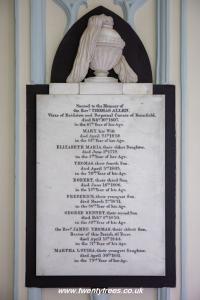
1744. St John's Church, Shobdon [Map]. Monument to various of the Bateman Family including: William Bateman 1st Viscount Culmore (age 49), John Bateman 2nd Viscount Culmore (age 22), Elizabeth Sambroke Viscountess Bateman (age 19) and Captain William Bateman.
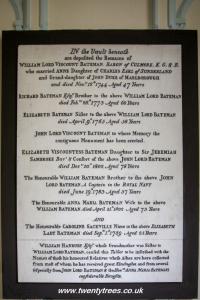
After 1819. St John's Church, Shobdon [Map]. Monument to Spencer Stanley Chichester (deceased) erected by his daughter Elizabeth Chichester Lady Bateman (age 19).
Spencer Stanley Chichester:
On 20 Apr 1775 he was born to Arthur Chichester 1st Marquess Donegal and Anne Hamilton Countess Donegal.
 Before 08 Jan 1797 Spencer Stanley Chichester and Anne Harriet Stewart were married. She the daughter of John Stewart 7th Earl Galloway and Anne Dashwood Countess Galloway. He the son of Arthur Chichester 1st Marquess Donegal and Anne Hamilton Countess Donegal. They were half second cousins.
Before 08 Jan 1797 Spencer Stanley Chichester and Anne Harriet Stewart were married. She the daughter of John Stewart 7th Earl Galloway and Anne Dashwood Countess Galloway. He the son of Arthur Chichester 1st Marquess Donegal and Anne Hamilton Countess Donegal. They were half second cousins.


 In 1819 Spencer Stanley Chichester died.
In 1819 Spencer Stanley Chichester died.
Elizabeth Chichester Lady Bateman:
On 17 Mar 1799 she was born to Spencer Stanley Chichester and Anne Harriet Stewart.
 In 1822 William Bateman-Hanbury 1st Baron Bateman and she were married.
On 19 Sep 1882 Elizabeth Chichester Lady Bateman died.
In 1822 William Bateman-Hanbury 1st Baron Bateman and she were married.
On 19 Sep 1882 Elizabeth Chichester Lady Bateman died.
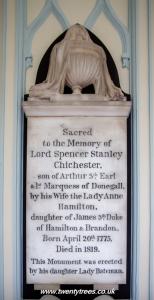
Archaeologia Volume 30 Section V. Dear Sir Henry,
I have the honor to exhibit to the Society of Antiquaries four plaster Casts of figures in alto relievo, from the south door of Kilpeck church, in Herefordshire. Two represent Apostles, holding the book of the Gospels, and a cross, with a nimbus at the back of each head: the other two are the effigies of Welsh Knights.
As specimens of infant Art the sculptures are not without interest; but our chief object in exhibiting them, is to call the attention of the Society to the Costume of the Knights. (Plate II.) They wear Phrygian caps, close vests of rayed texture, and trousers; and have knotted belts round their waists, fancifully disposed: one bears a long pointed sword, with a large guard at the hilt, and the other a speeies of mace.
The church of St. David of Kilpeck was given by Hugh, the son of William the Norman, (whose family afterwards assumed the surname of Kilpeck), to the monastery of St. Peter of Gloucester in 1134,1 and the present building was erected, we apprehend, not long after the appropriation. It is small, in the circular style throughout, and remarkable for the profusion of ornament used in the details, as may be seen in Mr. G. R. Lewis’s Illustrations of this Church.
Shobdon church [Map], in the neighbourhood of Kilpeck, of which only the chancel arch now remains, was built by Oliver de Merlymond, steward to Hugh de Mortimer, about the year 1140, and seems to have been a building in the same florid Norman style as that of Kilpeck. Among the figures sculptured on the arch noticed, are several with rayed vests and trousers.
In the same district is Eardesley church [Map], and, upon the Font there, figures will be found sculptured with the trouser.
The Gauls and Britons wore trousers as we know from Martial, Diodorus, and Strabo, and on some of the Roman coins of the Britannic type we have a personification of the Province in such a costume. The parts of Herefordshire lying without Offa’s Dyke were regarded, until the reign of Henry VIIL., as belonging to Wales.
Mr. Holford is in possession of a MS. formerly belonging to the family of Parker of Browsholme, and afterwards in the Townley collection, being the life and miracles of St. Edmund, King of East Anglia, written in the time of Anselm, Abbot of St. Edmund’s, who governed the monastery from the year 1119to 1148. This MS. contains various miniatures, and the character of the figure of St. Edmund is often similar in certain respects to that of the, Welsh knights ; and other figures in the MS. intended to represent Northmen as well as Anglo Saxons, occasionally appear habited in the trouser.
I am, Dear Sir Henry,
Yours faithfully,
JOHN GAGE ROKEWODE.
Note 1. Tanner’s Not. Monast.
1845. St John's Church, Shobdon [Map]. Monuments to William Bateman-Hanbury 1st Baron Bateman (age 64) and Elizabeth Chichester Lady Bateman (age 45) and to William Spencer Bateman-Hanbury 3rd Baron Bateman.
William Bateman-Hanbury 1st Baron Bateman: On 24 Jun 1780 he was born. In 1837 William Bateman-Hanbury 1st Baron Bateman was created 1st Baron Bateman of Shobdon. On 22 Jul 1845 he died. His son William Bateman-Hanbury 2nd Baron Bateman succeeded 2nd Baron Bateman of Shobdon.
William Spencer Bateman-Hanbury 3rd Baron Bateman: On 30 Sep 1856 he was born to William Bateman-Hanbury 2nd Baron Bateman. On 30 Nov 1901 William Bateman-Hanbury 2nd Baron Bateman died. His son William Spencer Bateman-Hanbury 3rd Baron Bateman succeeded 3rd Baron Bateman of Shobdon. On 04 Nov 1931 he died without issue. Baron Bateman of Shobdon extinct.
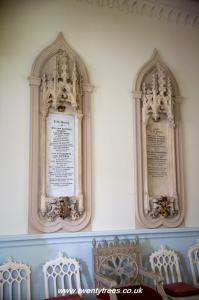
1931. St John's Church, Shobdon [Map]. Monuments to (left) Charles Stanhope Bateman-Hanbury (age 53) and (right) William Bateman-Hanbury 2nd Baron Bateman.
Charles Stanhope Bateman-Hanbury: On 13 Sep 1877 he was born to William Bateman-Hanbury 2nd Baron Bateman.
William Bateman-Hanbury 2nd Baron Bateman: On 28 Jul 1826 he was born to William Bateman-Hanbury 1st Baron Bateman. On 13 May 1854 he and Agnes Burrell Kerrison Baroness Hanbury were married. They had four sons and six daughters. She by marriage Baroness Bateman of Shobdon.
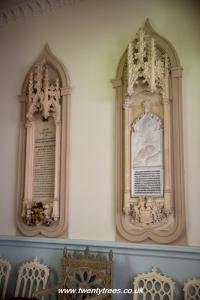
Europe, British Isles, England, Welsh March, Herefordshire, St Margaret's
Europe, British Isles, England, Welsh March, Herefordshire, St Margaret's, Park Wood Long Barrow [Map]
Park Wood Long Barrow is also in Cotswolds Neolithic Tombs.
Archaeological Journal Volume 11 Proceedings. Mr. Birch communicated further notices which he had received from Mr. Jenkins, of Hereford, relating to ancient remains in the neighbourhood of St. Margaret's Park and the cruciform earth-work already noticed in this Journal. (See vol. x. p. 358.) With permission of the proprietor excavations had been made in that singular embankment, at three different places, but without making any discovery: it has also been cleared of the brush-wood which encumbered it, and may now be fully examined. Not far distant may be noticed several basins or cavities of considerable size, supposed to have been possibly the sites of ancient habitations, and in one of these hollows some ancient pottery had been found, which, it is hoped, may be obtained for examination, as this might supply a clue to the probable date of these works. It was stated that a cross of metal had been found in the Park and sent to London. About 250 yards N.E. of the cruciform embankment in St. Margaret's Park there is a flat horizontal slab of limestone [Park Wood Long Barrow [Map]], like the upper stone of a cromlech. It is of an irregularly oval form, measuring about 27 feet 6 inches by 9 feet 6 inches; average thickness, 2 feet 6 inches in the direction of the longer diameter, being north and south. This stone lies on the declivity of the wooded hill, its face on the western side being level with the adjacent surface of the ground, and on this side there is a trench, 2 feet wide, and 2½ feet deep, which appears to have been at one time much deeper, and to have been filled up by soil brought down by the rain into it. On the east side, and partly on the north, the ground slopes from it, and a cavity appears under the slab. Half a century ago, as stated by an old man in the neighbourhood, it stood wholly free from the ground, resting on certain upright stones. There is still at the west end of the slab, but now at a slight distance from it, an upright stone, flat at top, which may have originally been one of those on which it was supported. It seems probable that these may be the remains of a fallen cromlech. About half a mile south of the cross-shaped mound and cavities above mentioned several objects of bronze have been found in ploughing, of a type hitherto, as it is believed, un noticed. They may have been fixed on the ends of spear-shafts, to serve the purpose of a ferrule. ( See woodcut, half length of original, ) The length of this object is 5 inches, the socket within tapers to a point 11 inch from the extremity.
Near St. Margaret's Church, about 500 yards west, and three quarters of a mile from the cross earthwork, the head-stone here represented (see woodcut) is to be seen in the fence of a tillage-field, under an aged yew tree, which leans, through the force of prevalent winds, in the same direc tion as the grave-slab at its foot. The dimensions are 4 feet by 17 inches. Tradition affirms that a lady was there buried, who came from London infected with the plague and died here. Another tale is, that seven persons were there interred at some remote period.
Long Barrows of the Cotswolds. Park Wood Long Barrow [Map]
Stapleton Castle, Herefordshire
On 08 Sep 1335 Geoffrey Cornwall 3rd Baron Burford was born to Richard Cornwall 2nd Baron Burford (age 22) and Sibella Bodrugan Baroness Burford at Stapleton Castle, Herefordshire [Map]. He a great x 3 grandson of King John "Lackland" of England.
Europe, British Isles, England, Welsh March, Herefordshire, Tarrington
In 1193 Sibyl Cormeilles was born to Walter Cormeilles at Tarrington, Herefordshire.
Europe, British Isles, England, Welsh March, Herefordshire, Titley
Europe, British Isles, England, Welsh March, Herefordshire, Titley, St Peter's Church
Before 13 Feb 1885 Reverend George Francis Coke (age 55) was appointed Vicar of St Peter's Church, Titley.
Europe, British Isles, England, Welsh March, Herefordshire, Wellington
Epiphanius Evesham was born at Wellington, Herefordshire.
Europe, British Isles, England, Welsh March, Herefordshire, Weobley
Florence of Worcester Continuation. 1138. Meanwhile, the city of Hereford, below the bridge over the river Wye, was burnt before his eyes. Not long afterwards, the lamentable conflagration of the city of Oxford reached the ears of the king and his court. The garrison of Hereford, perceiving of a surety by the numbers and strength of the royal army, that the king would triumph over them, made terms and surrendered to him. And since Stephen was, nay is1, a loving and peaceable king, he injured no one, but suffered his enemies to depart free. The king also took the fortified place called Wibbeleage2, which Geoffrey de Talbot held against him, but afterwards evacuated. It was by his devices and ability that the king's adversaries were supported in breaking the peace. The aforesaid castles and that of Hereford were garrisoned by the king's troops.
Note 1. Florence, it will be observed, speaks of what was actually passing, and seems, from his connection with Worcester, to have espoused the cause of king Stephen.
Note 2. Weobley, in Herefordshire.
Around 1430 Anne Devereux was born to Walter Devereux (age 43) and Elizabeth Merbury at Weobley, Herefordshire.
Around 1432 Walter Devereux Baron Ferrers of Chartley was born to Walter Devereux (age 45) and Elizabeth Merbury at Weobley, Herefordshire.
Europe, British Isles, England, Welsh March, Herefordshire, Weobley, Birley
Around 1325 John Burley was born to John Burley at Birley, Weobley.
Weobley Castle
In 1138 Gilbert de Lacy was besieged by King Stephen I England (age 44) at Weobley Castle [Map].

Europe, British Isles, England, Welsh March, Herefordshire, Whitbourne
On 26 Jun 1585 Bishop John Scory (age 75) died in Whitbourne, Herefordshire.
Europe, British Isles, England, Welsh March, Herefordshire, Wilton
On 28 Oct 1323 John Grey 2nd Baron Grey of Wilton (age 55) died at Wilton, Herefordshire. His son Henry Grey 3rd Baron Grey of Wilton (age 41) succeeded 3rd Baron Grey of Wilton.
Around 1331 Henry Grey was born to John Grey 3rd Baron Grey of Codnor (age 26) and Alice Lisle Baroness Grey Codnor (age 22) at Wilton, Herefordshire.

Around 1469 Edmund Grey 9th Baron Grey of Wilton was born to John Grey 8th Baron Grey of Wilton (age 21) and Anne Grey Baroness Grey Wilton (age 19) at Wilton, Herefordshire.
In 1492 Elizabeth Grey Baroness Chandos was born to Edmund Grey 9th Baron Grey of Wilton (age 23) and Florence Hastings Baroness Grey Wilton (age 19) at Wilton, Herefordshire.

On 05 May 1511 Edmund Grey 9th Baron Grey of Wilton (age 42) died at Wilton, Herefordshire. His son George Grey 10th Baron Grey of Wilton succeeded 10th Baron Grey of Wilton.
Around 02 Sep 1642 James Brydges 8th Baron Chandos was born to John Brydges 2nd Baronet (age 18) at Wilton, Herefordshire.
Wilton Castle, Herefordshire
In 1302 Maud Fitzhugh Baroness Grey Wilton (age 80) died at Wilton Castle, Herefordshire [Map].
Around 1526 Charles Brydges was born to John Brydges 1st Baron Chandos (age 33) and Elizabeth Grey Baroness Chandos (age 34) at Wilton Castle, Herefordshire [Map].
In 1573 Giles Brydges 1st Baronet was born to Charles Brydges (age 47) and Jane Carne at Wilton Castle, Herefordshire [Map]. Coefficient of inbreeding 12.52%.
Europe, British Isles, England, Welsh March, Herefordshire, Wormesley
Europe, British Isles, England, Welsh March, Herefordshire, Wormesley Priory [Map]
On 08 Sep 1274 Gilbert Talbot (age 54) died at Wormesley Priory [Map]. He was buried at Wormesley Priory [Map].
Europe, British Isles, England, Welsh March, Herefordshire, Yarpole
On 23 Dec 1519 Eleanor Cornwall (age 91) died at Yarpole, Herefordshire.
Europe, British Isles, England, Welsh March, Herefordshire, Yazor
On 26 Apr 1881 Delves Louis Broughton 10th Baronet (age 23) and Rosamond Broughton (age 19) were married at Yazor, Herefordshire.